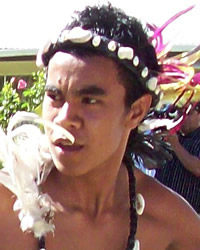People of French Polynesia and the Cook Islands are ethnically Maori. They are very closely linked in culture and language to the Maori of New Zealand and Australia. A more generic term would be Polynesian, referring all the peoples of the South Pacific islands.
Mission efforts radically altered the culture of the Cook Islands Maoris as well as other Polynesian peoples. In addition to leaving a new history of faith in God, missionaries introduced schools, medical centers, government structure, and improvements in agriculture. The latter, however, involved the introduction of powerful economic forces from outside. Cook Island Maoris lost control of their own land.
The missionaries influenced the traditional gender roles of Cook Island women by treating them as equal to the island men. Throughout the latter part of the 19th century, less importance was put on authority figures being solely male. As a result, some women became more influential in the public sphere. Other important changes brought by the missionaries include the replacement of the traditional tribal governing system, where hereditary chiefs were in control, with a centralized form of government with elected politicians. Missionaries also introduced the concept of a cash economy that replaced the traditional barter system. Lastly, missionaries are credited with bringing cotton usage for clothing, bedding, and home furnishings to the islands. Agriculture increased as more acreage was utilized for growing cotton.
Although fun-loving and friendly, Cook Islands Maoris, like Tahitians and other Polynesians, are conservative and generally religious people who adhere to their customary way of life and culture. Missionaries stamped their indelible mark on these islands in the 19th century.
Though there are differences in the cultures of the tiny islands scattered over a section of the South Pacific Ocean as big as the Indian sub-continent, there are also commonalities.
Food and meal sharing are prominent features in Polynesian cultures. Western notions of the importance of the individual are entirely alien to them; they had to adjust when Western powers took their island homes. They see themselves as members of a race, a people, a party, or some other general group in much the same way that many societies do.
One of a male's most significant functions is organizing and paying for feasts. A chief, or indeed, any man, is judged by his ability and willingness to bestow gifts and throw big parties.
One outstanding ability that all Cook Islands Maoris share is music (playing and singing). Close harmony singing is highly developed in church music and the power and emotional impact of chants and hymns at weddings and funerals is well known to visitors. The range and talent of popular singing/singers can be seen at the numerous festivals throughout the year. Each island has its own songs and the various island groups fiercely compete. Numerous Polynesian string bands play at restaurants, hotels, and concerts. They use combinations of modern electronic instruments and traditional ones, including ukuleles fashioned from coconut shells.
Painting, wood carving, basalt, and limestone sculptures are common art forms of the Cook Island Maoris. The distance between the islands likely contributed to slight differences in style, yet there is a cohesiveness of general style. The effects of modernization upon younger generations have deterred them from learning traditional arts. Local Maori are trying to preserve their traditional wood carvings and sculptures. Their crafts also include woven mats, baskets, hats, and decorative trims for hats and clothing. Tivaevae is a patchwork quilt-making skill that was learned from the 19th-century missionaries. In the past, quilt-making was a popular community activity. Maoris sell handmade quilts in fine art galleries and shops.
The dominant religion of the Maoris is Christianity. Missionaries quickly uprooted the traditional worship of tribal gods and idols. The Cook Island Maoris are well-equipped to be Christ's ambassadors in other locations.
Discipleship and Scripture-oriented teaching and preaching need to become prominent. Even more so, they must disciple others in Christ's ways and teach others to do the same.
Pray for local Cook Island Maori Christ followers to disciple those who are weak in the faith.
Pray for Biblical Christianity to prevail above any other spiritual belief.
Pray for their protection and provision while they engage in spiritual warfare.
Pray for God to raise up Maoris will take the gospel to neighboring islands and into other nations.
Scripture Prayers for the Cook Islands Maori in Cook Islands.
Wallace Revels
https://en.wikipedia.org/wiki/Cook_Islands_M%C4%81ori
https://en.wikipedia.org/wiki/M%C4%81ori_people
| Profile Source: Joshua Project |










